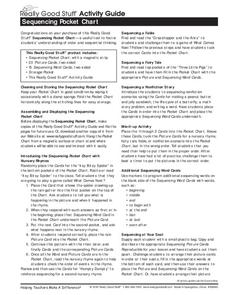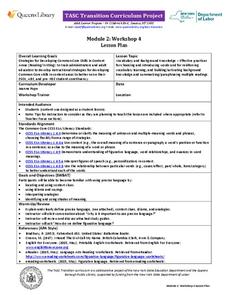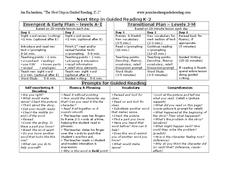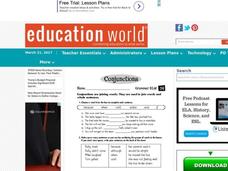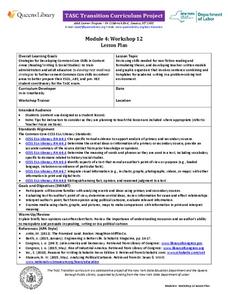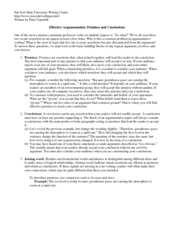Curated OER
Breaking News English: Happy Marriages
In this happy marriages instructional activity, students read the article, answer true and false questions, complete synonym matching, complete phrase matching, complete a gap fill, answer short answer questions, answer discussion...
Curated OER
Because Of, Due To, Owing To
In this word choice worksheet, learners learn the correct use of three transition terms: because of, due to, and owing to. After reading the rules and studying the examples, students rewrite 5 sentences.
Curated OER
Writing a Good Introduction
Fifth graders use a list of transitional words and hooks in order to write a good introduction. For this writing lesson plan, 5th graders view and discuss a PowerPoint presentation on introductions.
EngageNY
End of Unit Assessment: Final Essay
This is just the transition phase. Scholars participate in a mini lesson about using transitions in writing. They then have a brief peer critique of the introduction and conclusion paragraphs for their end of unit assessment. Learners...
Really Good Stuff
Sequencing Pocket Chart
Cut it out! Beginning readers practice sequencing skills at home or at school with a variety of activities that require cutting out multiple sets of picture cards and putting them in the correct order.
Curated OER
Connectives
Using connectives and conjunctions is an easy way to vary sentence structure. Third graders review the given connectives, then use them to combine two simple sentences. The second section allows learners to use more words and phrases as...
Curated OER
Sequence, Predict, Infer: Pink and Say
Practice sequencing with your 2nd graders via Patricia Polacco's Civil War book Pink and Say. Begin with a blindfold and a bag of mystery items. Connect their use of clues to identify what they can't see with the skill of making...
Curated OER
In the Right Order
What comes first? Practice order of events with this sequencing activity. Learners examine two sets of pictures and write 1st, 2nd, and 3rd beneath the corresponding pictures. Encourage them to explain their reasoning, as there may be...
Curated OER
Compound and Complex Sentences
Does your class need to work on compound and complex sentences? Consider this worksheet! This fine worksheet has learners use connecting words to join 8 sentences, so that simple sentences become compound and complex sentences. They also...
New York State Education Department
TASC Transition Curriculum: Workshop 4
Why is it important to use precise language? Participants explore this question in the fourth activity in a series of 15 on effective instruction. Perfect for all content areas, the activity promotes appropriate language choice through...
Curated OER
Number Writing Poems
Students read the short poem for each number to help them with number formation. In this numbers lesson plan, students follow directions of the poems.
Curated OER
The Use of Signal Words in Writing
Students examine the use of transition or signal word to create good paragraph organization.
Wisconsin State Reading Association
Next Step in Guided Reading
Here are three guided reading lesson plan templates; each designed to meet the needs of a specific level of readers. Levels in focus are emergent, early, and transitional readers. Additionally, prompts to support your small group...
Curated OER
So & So That
When do you use "so" or "so that"? Practice this skill with your ESL students in this worksheet, which includes twenty multiple-choice questions. Each question prompts English learners to choose the correct way to complete the...
EngageNY
Grade 10 ELA Module 3: Unit 3, Lesson 6
And that's a wrap! Scholars create their concluding statement drafts by examining model text with exemplar conclusions. In pairs, they discuss how transitional words and phrases add to sentence structure and consider how their concluding...
Curated OER
Conjunctions
In this grammar worksheet, students choose a correct conjunction to complete six sentences. Students write sentences by combining given groups of words. Students combine sentences by using a conjunction.
Curated OER
VCOP
Ambitious vocabulary, various connectives, interesting openers, and a punctuation pyramid are provided in this colorful PowerPoint. Your pupils will be on their way to becoming fantastic VCOP detectives with the great pointers and...
Curated OER
Five Minute Quickies
Challenge your class to take just five minutes to complete the tasks in each slide. The end result will be a short story. Each text includes writing a certain element of a story: opener, ending, characters, and more. After completing...
Curated OER
Parts of Speech
This online multiple choice quiz focuses on upper-level grammar concepts. In addition to covering simple parts of speech such as nouns, verbs, and adjectives, this resource also covers more advanced information, such as transitive vs....
EngageNY
TASC Transition Curriculum: Workshop 12
How can opinions slant facts? Workshop participants learn how to examine primary and secondary sources and identify the author's point of view. They also examine how visual art impacts the meaning and rhetoric of sources. Full of...
Curated OER
Language Arts: Who Am I?
Twelfth graders write self-identity essays of three to five paragraphs in length. They include topic sentences, transition words, and concluding paragraphs in their essays, They read their essays to classmates.
Curated OER
The Correct Use of the Articles "A" and "An"
Students discover the grammatical rules regarding articles. In this grammar lesson, students study the rule regarding the use of "a" and "an" in writing. Students are encouraged to discover the rule on their own and apply the rule while...
Curated OER
All About Me
Young scholars explore autobiographical stories. They write about a personal experience that is significant and memorable. Students specifically explain the chosen events. They define autobiography and share their stories.
San José State University
Effective Argumentation: Premises and Conclusions
Augment argumentative skills with this handout and brief exercise. This resource outlines premises, conclusions, and joining words, and explains how these make up the foundation of logical arguments. After reading through this...






